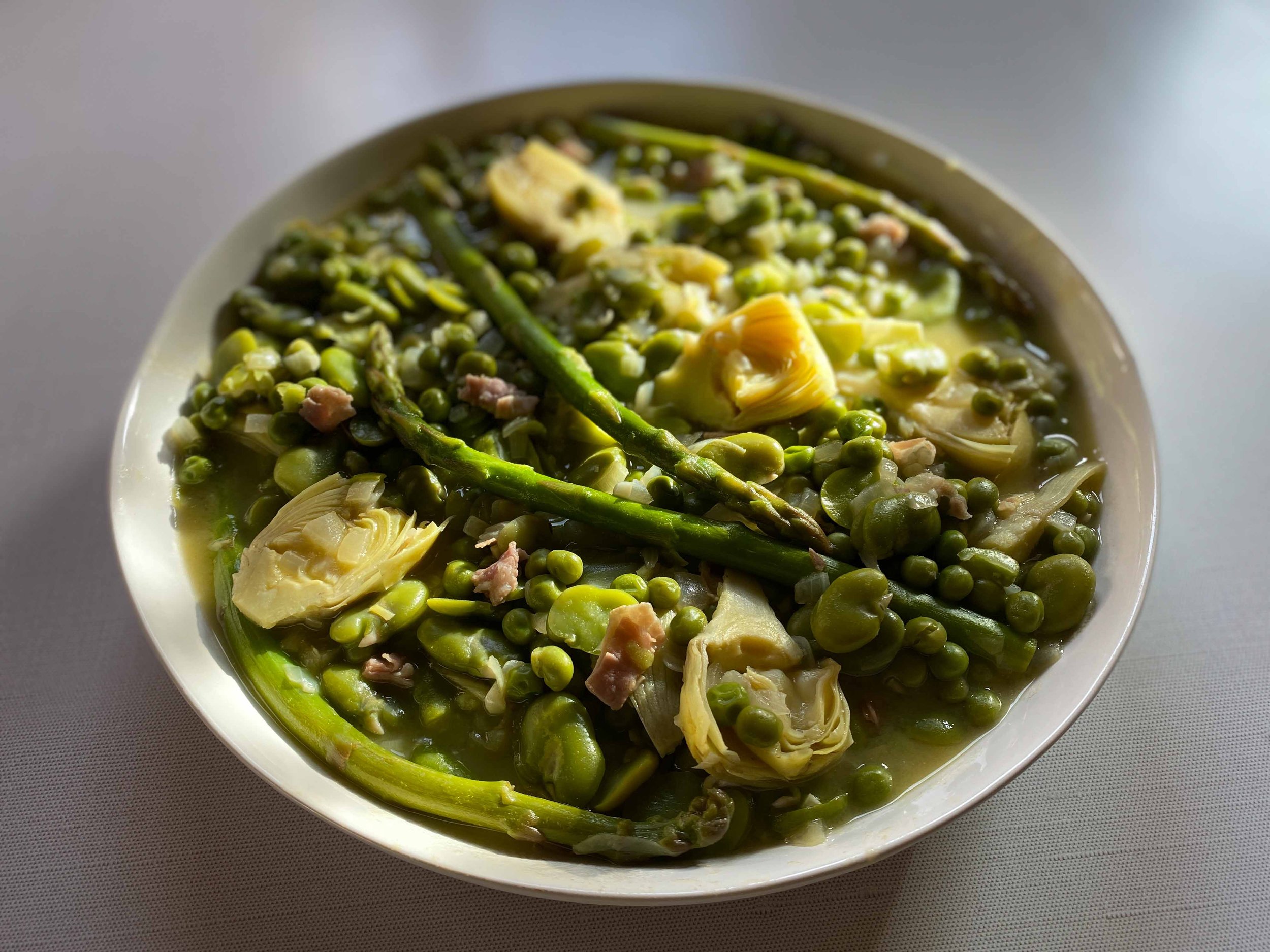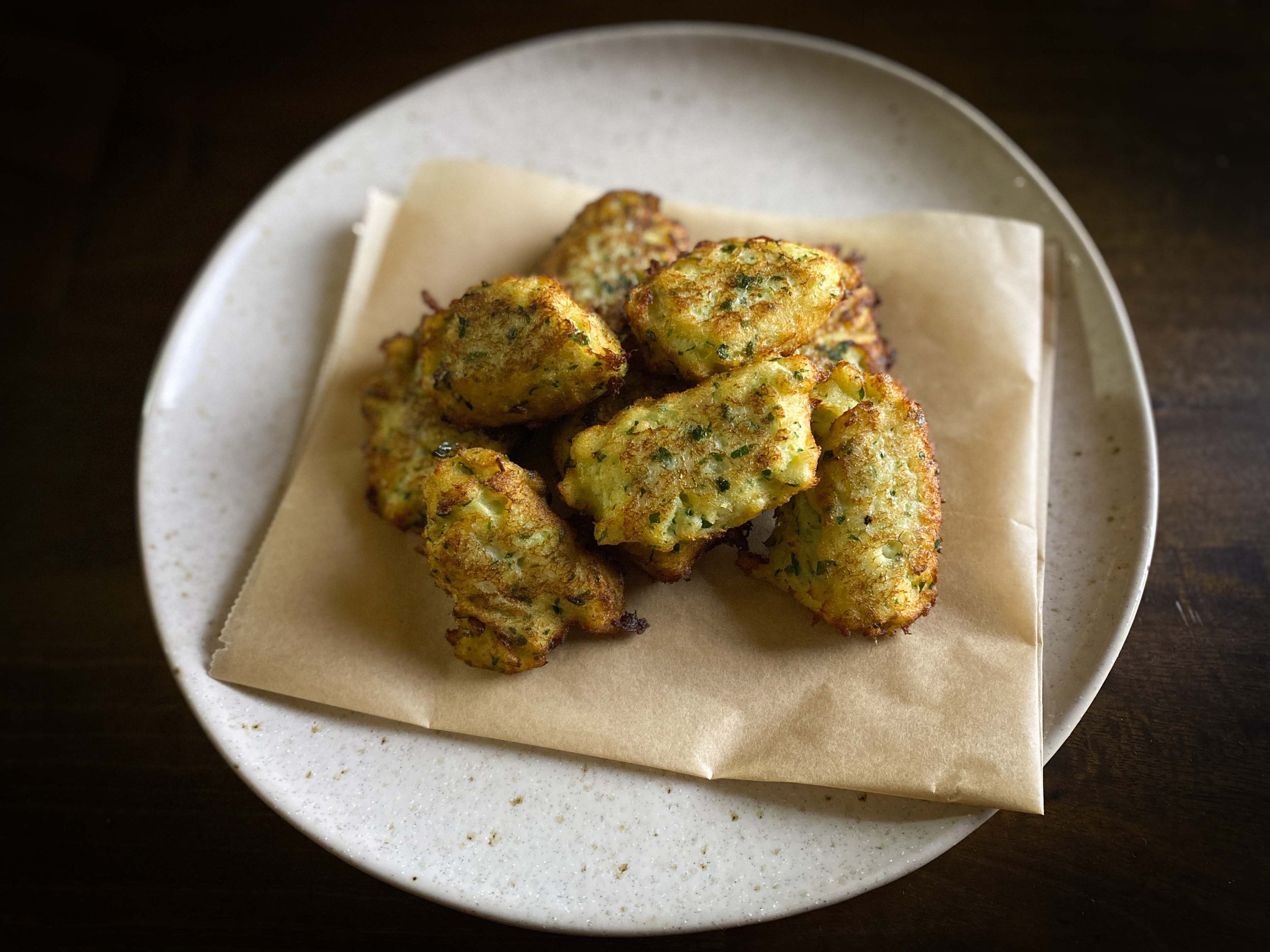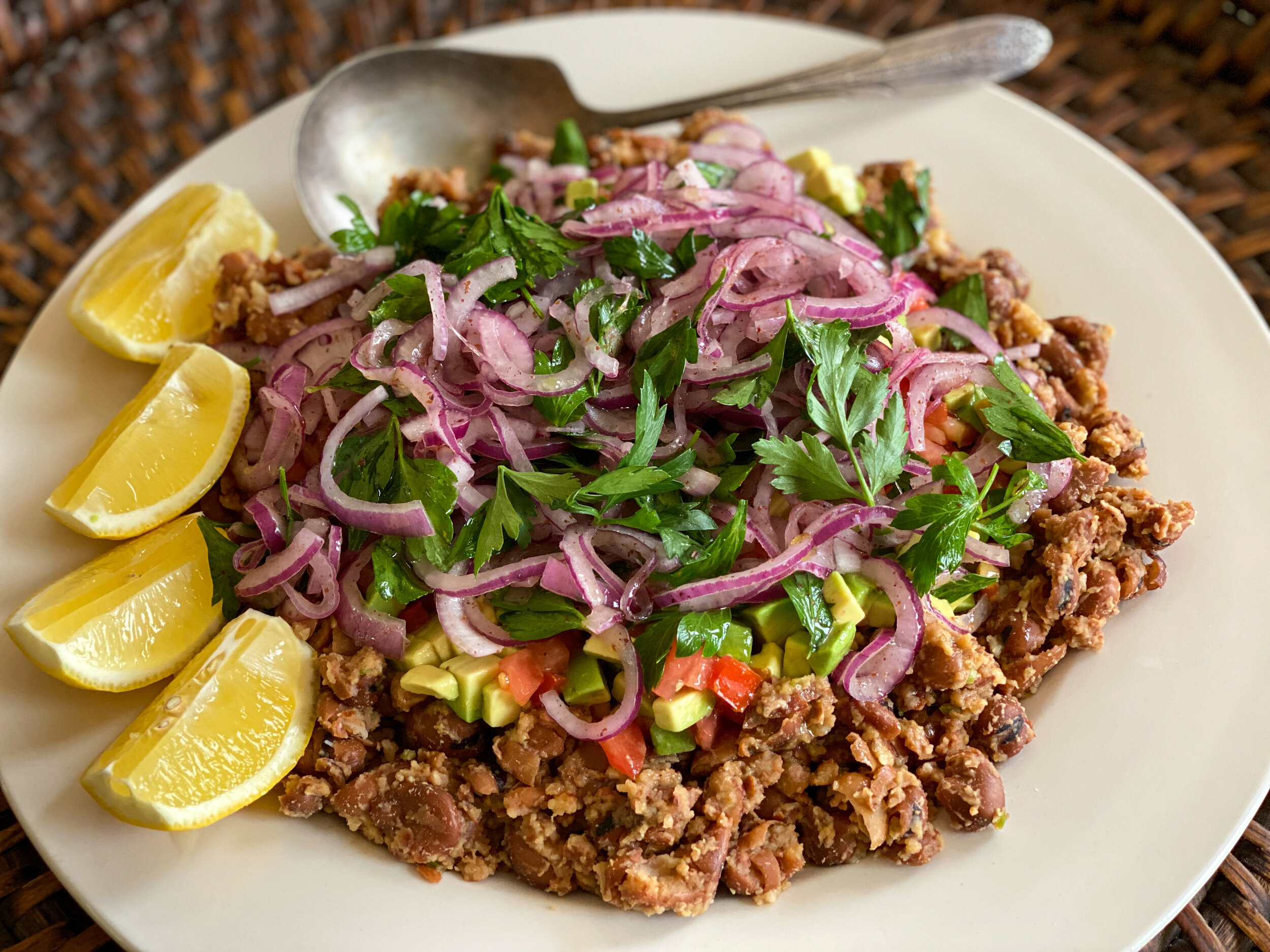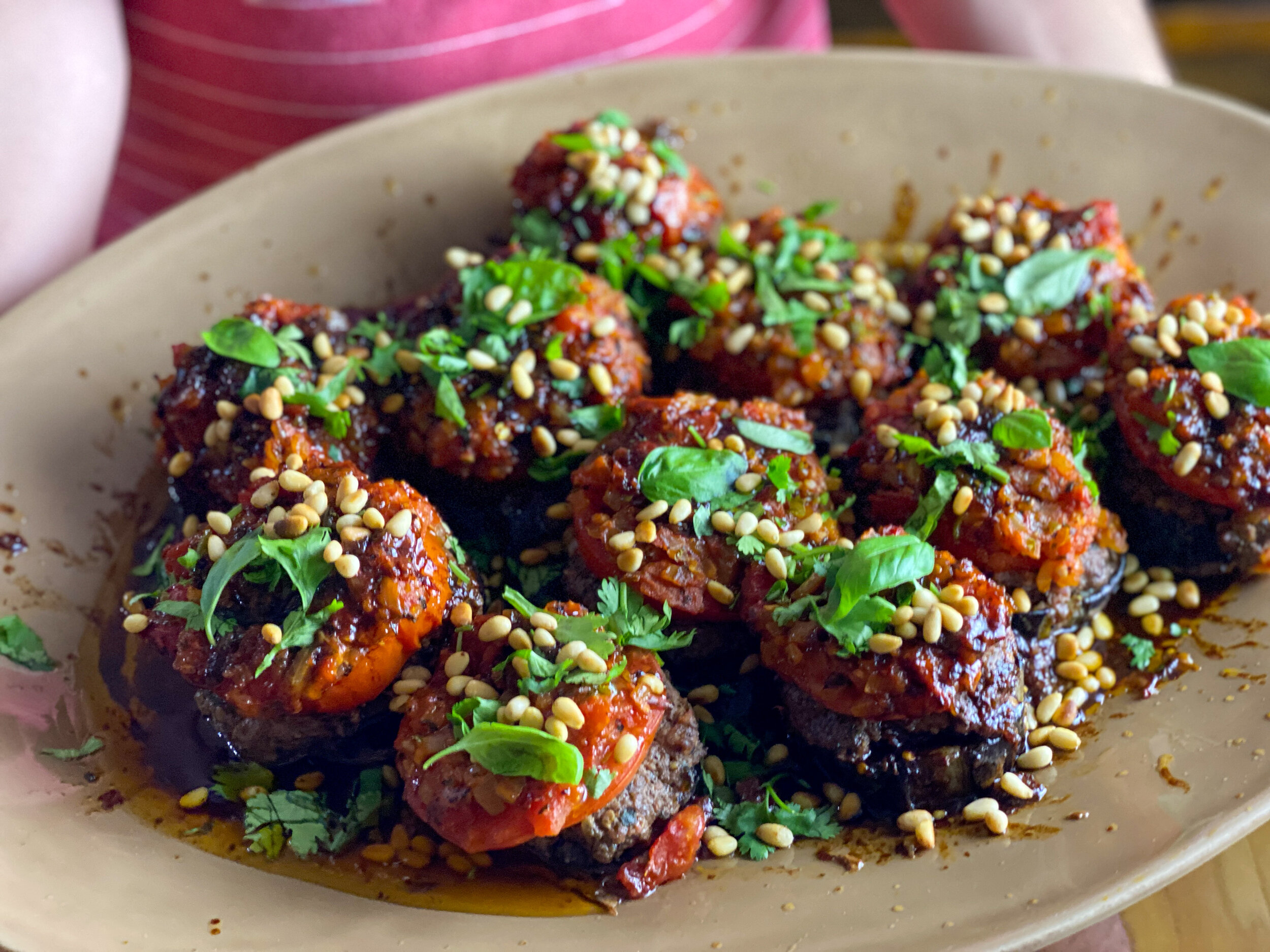Medley of Spring Vegetables from Claudia Roden’s ‘The Food of Spain’
By Leslie Brenner
[Women have a history of writing the best cookbooks. That’s why throughout March — Women’s History Month — we’ll be featuring cookbooks by our favorite female authors.]
If I had to choose just one cookbook author and live with only that author’s books for the rest of my life, it might well be Claudia Roden. Somehow, after decades of cooking, I haven’t paid nearly enough attention to the widely lauded, highly accomplished, deeply interesting 87-year-old author of 20 cookbooks. Foolish, foolish me!
I own four Roden titles, and I’ve cooked from them all, always with excellent results. I’ve called upon her books frequently for research; they’ve informed my approach to baba ganoush and helped me develop a recipe for pita bread. But somehow I have rarely just relaxed and cooked from Roden’s books, and never fully recognized how much I love them. It’s a little like one of those old-fashioned romantic comedies where the young, handsome, gallivanting star suddenly sees that the love of his life has been right there under his nose the whole time: the girl next door. Only I’m not young, handsome or a gadabout, and Claudia Roden is definitely not the girl next door.
Born in Cairo, Egypt to Jewish-Syrian parents and now based in London, Roden has made a brilliant career of studying and writing about the foods of the Middle East and Mediterranean. Her 2011 title, The Food of Spain — a 609-page magnum opus — won first prize for International Cookbooks by the International Association of Culinary Professionals. Her 1968 book, The New Book of Middle Eastern Food, was updated 32 years later, then inducted in 2010 in the James Beard Foundation’s Cookbook Hall of Fame. In 1997, The Book of Jewish Food: An Odyssey from Samarkand to New York won the James Beard Award for Cookbook of the Year.
Ab Ghooshte Fasl (Iranian Bean Soup) from Claudia Roden’s ‘The New Book of Middle Eastern Food’
I love Roden’s aesthetic, she’s a great cook and a captivating food historian. Just about any other author I might choose to focus on for the rest of my life would have depth of knowledge in one or two, or maybe three food cultures. Roden has taken deep dives into so many. In one book alone — The New Book of Middle Eastern Food — she covers Albanian, Algerian, Armenian, Bedouin, Egyptian, Greek, Iranian, Tunisian, Turkish, Syrian, etc. etc., the work of more than two decades. She spent five intensive years researching Spanish cooking for the aforementioned magnum opus. Arabesque focuses on Morocco, Turkey and Lebanon.
As if that weren’t enough, 16 months ago she published Claudia Roden’s Mediterranean: Treasured Recipes from a Lifetime of Travel. And you know what? If you think the world already had enough Mediterranean cookbooks, it didn’t — Roden’s is one of the most quietly captivating ever published.
In the Introduction, Roden writes that after her children left home thirty-five years earlier, she embarked on a solo trip all around the Mediterranean inspired by a childhood memory of visiting Alexandria. Traveling alone was “strange and suspect” in those days, but it allowed her to meet people everywhere. “My interest was in home cooking and regional food,” she writes. “I was invited into homes where people still cooked as their parents and grandparents did.”
After so many decades, the Mediterranean — and all that she has encountered in her travels — continues to inspire her. Working on this particular book, she explains,
“has kept me happy, thinking of people and places, magic moments, and glorious food. It might be cold and raining outside, but in my kitchen and at my desk in London I am smiling under an azure sky. The smell of garlic sizzling with crushed coriander seeds takes me back to the Egypt of my childhood. The aroma of saffron and orange zest mingled with aniseeed and garlic triggers memories of the French Riviera.”
How beautiful is that?
I only started cooking from that last book a month ago; there are enticing recipes on nearly every page. The first dish I made was so wonderful, I made it again two weeks later: chicken thighs baked saucily with green olives, boiled lemons and lots of garlic. To accompany it Roden offers (practically in an aside), the most brilliant method for making couscous I’ve ever found — you pour salted warm water over the grains, stir them, let them swell for 10 minutes, then add olive oil and rub the couscous between your hands to “aerate the grains” and break up lumps. Cover it with foil and bake it for 10 or 15 minutes. The result is nearly as perfect as the traditional way, when you painstakingly moisten, rub, and steam the grains two or three times. I promise recipes soon, accompanying a review of the book.
Till then, please treat yourself to these Roden recipes:
Tender veg for early spring
If you can’t wait for spring, try this Medley of Spring Vegetables, inspired by the traditional Spanish soup menestra de primavera, from The Food of Spain. I made it last night, and I’d make it again next week.
RECIPE: Claudia Roden’s Medley of Spring Vegetables
Soup for a chilly late-winter day
On a cold day (there are surely still a few to come this season), simmer a pot of Ab Ghooshte Fasl — Iranian Bean Soup. The recipe is adapted from The New Book of Middle Eastern Food.
RECIPE: Ab Ghooshte Fasl (Iranian Bean Soup)
Savory snack for anytime
Cod Fritters from Claudia Roden’s ‘The Food of Spain’
Finally, these tender, fabulous Buñuelos de Bacalao — Cod Fritters — are made with fresh fish rather than salt cod. That means no soaking the fish, so you don’t have to think about them a day in advance.
RECIPE: Buñuelos de Bacalao (Cod Fritters)
I’ve only just scratched the surface in discovering all this cookbook giant has to offer. Hopefully I still have a long cooking life ahead of me because Roden’s thousands and thousands of pages promise infinite deliciousness.
Find more cookbook reviews from Cooks Without Borders










